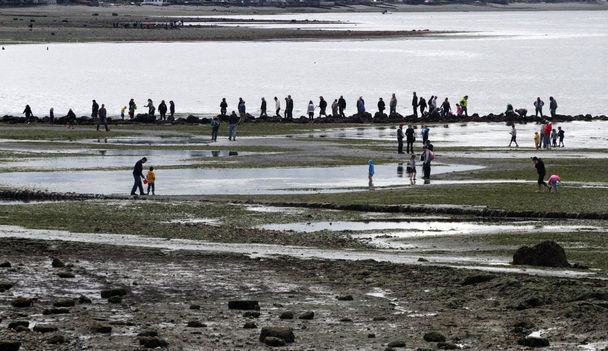Now comes our season of daylight low tides, and the pleasure of beach walks. Volunteer naturalists with the Seattle Aquarium have kicked off a season of naturalist-led walks on beaches all over Puget Sound, beginning over Memorial Day weekend.

A -3.3 low tide draws beach explorers to Constellation Park in West Seattle on Saturday for one of the lowest of the year.
By Lynda V. Mapes, Seattle Times staff reporter
As spring waxes to summer, our season of daylight low tides is under way, revealing wonders of Puget Sound right at our feet.
Volunteer naturalists from the Seattle Aquarium over the Memorial Day weekend kicked off a series of low-tide beach walks offered all over the Puget Sound area. The walks will continue through July, and some of the best low tides are yet to come.
On Sunday, the Sound waters slid down the clean, gray sand at the aquatic reserve at the Constellation Park Marine Reserve at Alki. Clams jetted their silvery squirts, and jet-black crows strutted the tide flats, probing for tasty morsels. The pearly light and hush-shush of the tide made this stretch of beach feel far away from the bustle of Alki’s commercial strip, just around the point.
The signature scent of low tide — tangy saltwater and algae — and a cooling breeze off the water beckoned visitors to come under the spell of another world: the intertidal zone, usually out of our reach, but right there to explore during a -3.6 low tide.
Sea stars clung fiercely to the rocks, their soda-pop purple color contrasting with the bright-red shells of rock crabs. Their diminutive size belies pincer power 10 times the might of Dungeness crabs.
The smooth, curved gray collars of moon snail shell egg casings lay amid jade-green eel grass and heaps of nubby, bronze algae aptly named Turkish towel for its pot-scrubber texture.
Everywhere was the sound of children’s laughter as they peeked under rocks and into tide pools. Oliver Straley’s eyes got big as Craig “Mac” MacGowan, a retired Seattle teacher, put a nudibranch in Straley’s wetted palm.
He gently touched the shell-less mollusk with a wetted finger, then carefully replaced it on the clean, gray sand. “It was sort of slimy,” said Straley, 9. “Gooey and soft. It was cool!”
His sister Georgia, 10, was just as enthralled. “We saw sun stars and clam shells and moon snails,” she said. “I like finding different stuff that I wouldn’t normally see.”
That went for the adults, too.
“This place is so rich in life,” MacGowan said. “And we didn’t even touch a fraction of it. This is a rocky beach. But there’s also sand, mud, all of it’s different. There are more different types of animals on these beaches than there are people in Seattle. No matter where you go, it’s all good, you just have to get out and look at it.”
Volunteer naturalist Rebecca Gamboa said she has been leading walks on Seattle beaches for years, partly just to make sure she gets outside herself.
“We’ve had people come on walks say they’ve lived here 25 years and didn’t even know this existed,” Gamboa said. “I’ve met third- and fourth-graders who say it’s their first time at the beach.
“It’s a huge opportunity to see a whole new world.”
Low-tide walks with naturalists
Free beach walks occur during low tides throughout June and July at Richmond Beach Park, Carkeek Park, Golden Gardens Park, Constellation Park/South Alki, Lincoln Park, Seahurst Park and Des Moines Beach Park, and even Blake Island.
Look for trained, volunteer beach naturalists courtesy of the Seattle Aquarium in red hats at the beaches.
For complete lists of dates and hours and driving directions to the beaches, go online: www.seattleaquarium.org/beach-naturalist
